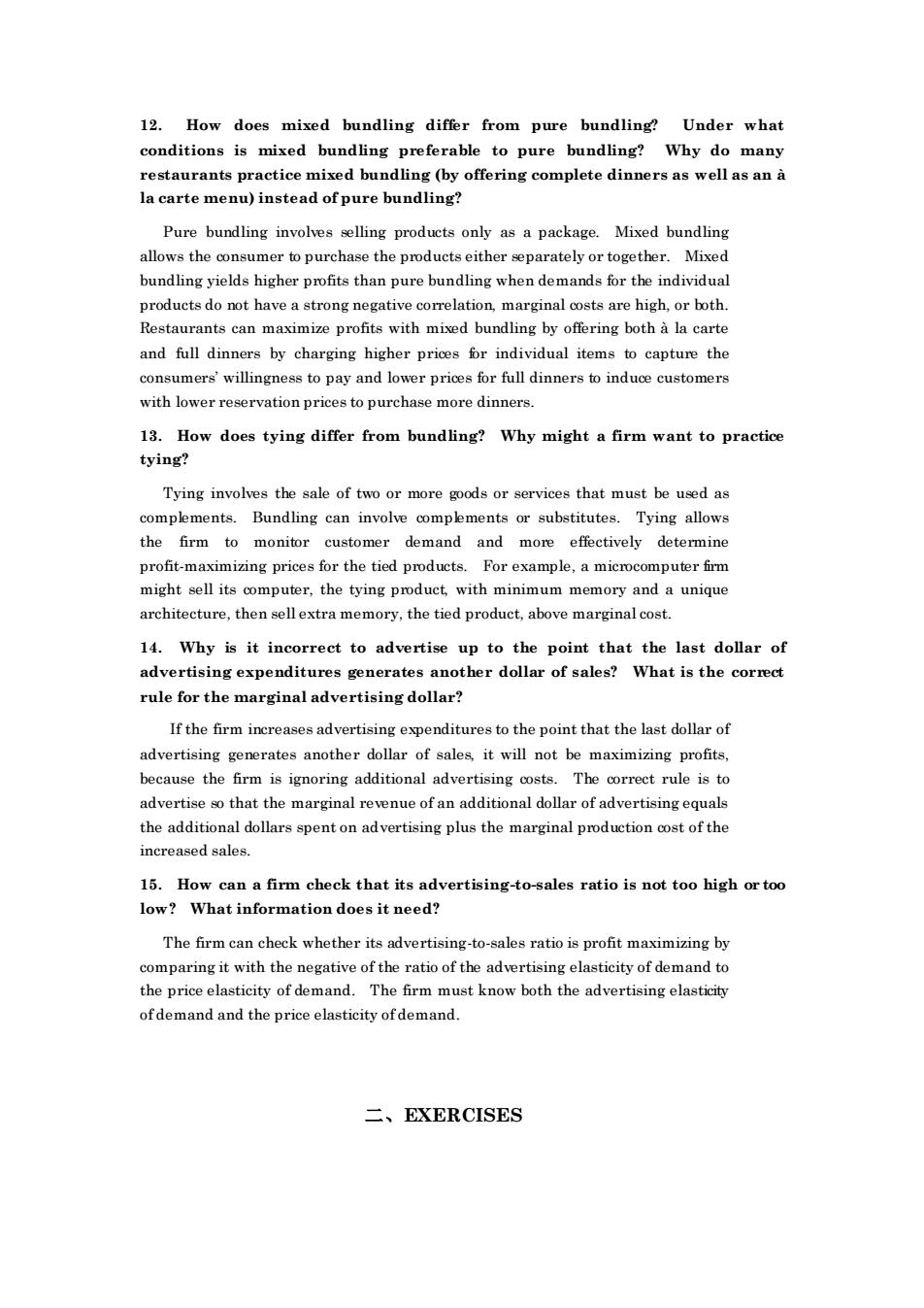正在加载图片...

12.How does mixed bundling differ from pure bundling?Under what conditions is mixed bundling preferable to pure bundling? Why do many restaurants practice mixed bundling(by offering complete dinners as well as an a la carte menu)instead ofpure bundling? Pure bundling involves selling products only as a package.Mixed bundling allows the consumer to purchase the products either separately or together.Mixed bundling yields higher profits than pure bundling when demands for the individual e a strong negativ s are high or both taurants can maximize profits with mixed bundling by offering both a la carte and full dinners by charging higher prices for individual items to capture the consumers'willingness to pay and lower prices for full dinners to induce customers with lower reservation prices to purchase more dinners. 13.How does tying differ from bundling?Why might a firm want to practice tying? Tying involves the sale of two that must beused as complements s.Bundling can involve complments or substitutes. Tying allows the firm to monitor customer demand and more effectively determine profit-maximizing prices for the tied products.For example,a microcomputer firm might sell its computer,the tying product with minimum memory and a unique architecture.then slextra memory.the tied product.above marginal cost. 14.Why is it incorreet to advertise up to the point that the last dollar of advertising expenditures generates another dollar of sales?What is the cor rule for the marginal advertising dollar? If the firm increases advertising expenditures to the point that the last dollar of advertising generates another dollar of sales.it will not be maximizing profits. because the firm is ignoring additional advertising costs.The correct rule is to advertise so that the marginal revenue of an additional dollar of adv the addi rtisingeq increased sales 15.How can a firm check that its advertising-to-sales ratio is not too high or too low?What information does it need? The firm can check whether its advertising-to-sales ratio is profit maximizing by comparing it with the negative of the ratio of the advertising elasticity of demand to the price elasticity of demand.The firm must know both the advertising elasticity ofde and and the price elasticity ofdemand. 二、EXERCISES12. How does mixed bundling differ from pure bundling? Under what conditions is mixed bundling preferable to pure bundling? Why do many restaurants practice mixed bundling (by offering complete dinners as well as an à la carte menu) instead of pure bundling? Pure bundling involves selling products only as a package. Mixed bundling allows the consumer to purchase the products either separately or together. Mixed bundling yields higher profits than pure bundling when demands for the individual products do not have a strong negative correlation, marginal costs are high, or both. Restaurants can maximize profits with mixed bundling by offering both à la carte and full dinners by charging higher prices for individual items to capture the consumers’ willingness to pay and lower prices for full dinners to induce customers with lower reservation prices to purchase more dinners. 13. How does tying differ from bundling? Why might a firm want to practice tying? Tying involves the sale of two or more goods or services that must be used as complements. Bundling can involve complements or substitutes. Tying allows the firm to monitor customer demand and more effectively determine profit-maximizing prices for the tied products. For example, a microcomputer firm might sell its computer, the tying product, with minimum memory and a unique architecture, then sell extra memory, the tied product, above marginal cost. 14. Why is it incorrect to advertise up to the point that the last dollar of advertising expenditures generates another dollar of sales? What is the correct rule for the marginal advertising dollar? If the firm increases advertising expenditures to the point that the last dollar of advertising generates another dollar of sales, it will not be maximizing profits, because the firm is ignoring additional advertising costs. The correct rule is to advertise so that the marginal revenue of an additional dollar of advertising equals the additional dollars spent on advertising plus the marginal production cost of the increased sales. 15. How can a firm check that its advertising-to-sales ratio is not too high or too low? What information does it need? The firm can check whether its advertising-to-sales ratio is profit maximizing by comparing it with the negative of the ratio of the advertising elasticity of demand to the price elasticity of demand. The firm must know both the advertising elasticity of demand and the price elasticity of demand. 二、EXERCISES